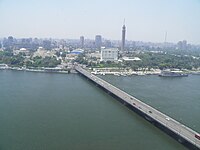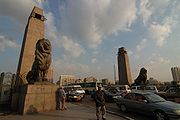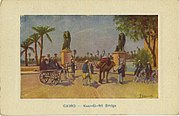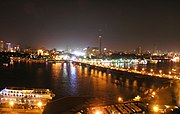Qasr El Nil Bridge
Qasr El Nil Bridge | |
|---|---|
 View of the Qasr El Nil Bridge, with Gezira Island in the background. | |
| Coordinates | 30°02′37″N 31°13′46″E / 30.043747°N 31.229464°E |
| Carries | Tahrir Street[1] |
| Characteristics | |
| Design | arch[1] |
| Material | Steel[1] |
| Total length | 1 932 m[1] |
| No. of spans | 7 |
| History | |
| Designer | Ralph Anthony Freeman[1] |
| Engineering design by | Dorman, Long and Co. Ltd.[1] |
| Construction start | 1931[1] |
| Construction end | 1933[1] |
| Construction cost | 308,000 EGP |
| Opened | June 6, 1933 |
| Replaces | El Gezira Bridge (1872)[1] |
| Location | |
 | |
The Qasr El Nil Bridge (originally named Khedive Ismail Bridge), also commonly spelled Kasr El Nil Bridge, is a historic structure dating from 1931 which replaced the first bridge to span the Nile River in central Cairo, Egypt. It connects Tahrir Square in downtown Cairo to the modern Cairo Opera complex toward the southern end of Gezira Island. At the bridge's east and west approaches are four famous large bronze lion statues; they are late 19th-century works by Henri Alfred Jacquemart, French sculptor and animalier. The newer and wider 6th October Bridge parallels its route 0.8 kilometres (0.50 mi) just to the north.
Route[]
Qasr El Nil Street crosses over the Nile on the bridge, from the east bank area Tahrir Square—Liberation Square in downtown Cairo, past the huge Mogamma government building and the headquarters of the Arab League, then onto the Qasr El Nil Bridge over the river to Gezira Island. There it meets Opera Square and the Cairo Opera House, with connections north to the Cairo Tower and the Zamalek district, and south across the island to the across a smaller branch of the Nile to Tahrir Street in the Agouza district on the west bank.
Construction and name[]

The previous bridge on the site, El Gezira Bridge, was built between 1869 and 1871 by Linant de Bellefonds with the participation of France's Five-Lilles Company.[2] The foundation stone for the present Qasr El Nil Bridge was laid by King Fuad I on February 4, 1931.[1] After over two years of construction, undertaken by Dorman Long & Co. Ltd, King Fuad inaugurated the bridge's opening on June 6, 1933.[2]
The bridge was originally named Khedive Ismail Bridge after King Fuad's father, Khedive Isma'il Pasha. After the Egyptian Revolution of 1952, the bridge was renamed, along with other Egyptian buildings and bridges. This bridge was renamed Qasr El Nil in Arabic, which translates to Palace of the Nile.[3]
Public use and demonstrations[]
The Qasr El Nil Bridge, with sidewalks, is popular for strolling in the evenings. The bridge offers views of the river, as well as landmark buildings, hotels, and other structures on the island and along the Nile corniche on the west bank. The bridge is popular as a location for young Egyptian friends and couples to have an inexpensive outdoor date.
2011 Egyptian Revolution[]
The bridge, along with the nearby 6th October Bridge, was a regular site in the 2011 Egyptian revolution for public demonstrations and as a major route east to protest gatherings in Tahrir Square.[4]
Gallery[]

View of western bridge end with lions (circa 1930s).

View of eastern bridge end with obelisks and lions, circa 2000s.

Crowds and police on the bridge during the 2011 Egyptian revolution.
View of the bridge at night.

Cairo - Kasr-El-Nil Bridge

Setting the lions in place on the Ismail bridge.
References[]
- ^ Jump up to: a b c d e f g h i j Kasr el Nil Bridge - Structurae
- ^ Jump up to: a b A bridge misunderstood
- ^ Fleishman, Jeffrey (August 14, 2007). "Cairo's bridge of dreams". Los Angeles Times.
- ^ BBC News: "Egypt protests: curfew defied in Cairo and other cities" 29 January 2011. accessed 2011.01.29.
External links[]
| Wikimedia Commons has media related to Qasr al-Nil Bridge. |
- Bridges in Cairo
- Bridges over the Nile
- Bridges completed in 1933
- Downtown Cairo
- Gezira Island
- Tourist attractions in Cairo






